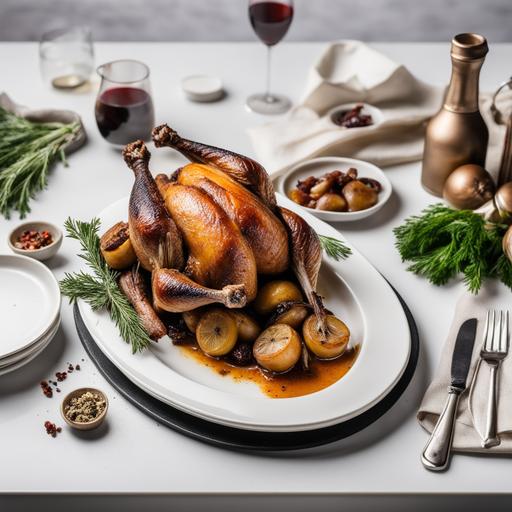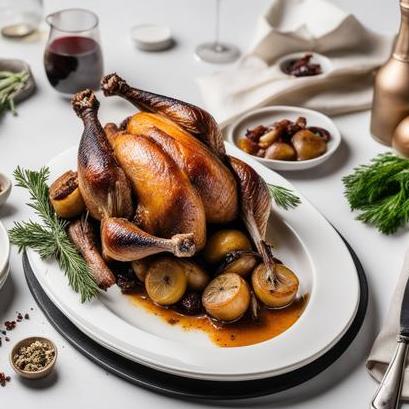- You are here:
- Home »
- Oven Recipes
- » Pheasant Oven Recipe: A Culinary Delight

Pheasant Oven Recipe: A Culinary Delight
Are you looking to indulge in a tantalizing and elegant meal? Look no further than the pheasant oven recipe! Pheasant, a delicious game bird, offers a unique and rich flavor that is sure to impress even the most discerning palates. With its succulent meat and versatile cooking methods, this recipe allows you to create a masterpiece in your own kitchen. In this comprehensive guide, we will delve into the intricacies of preparing pheasant, exploring its culinary details, selection, cleaning, preparation, tips, variations, doneness checks, recipe, and other essential sections.
Understanding Pheasant: The Science behind the Flavor
Pheasant, scientifically known as Phasianus colchicus, belongs to the Phasianidae family and is a bird species native to Asia. Its distinctive taste is attributed to its diet, which primarily consists of grains, seeds, and various wild vegetation. This unique foraging pattern contributes to the development of a complex flavor profile, making pheasant a true epicurean delight.
Selecting the Perfect Pheasant
When choosing a pheasant for your culinary journey, it’s crucial to opt for a fresh and high-quality bird. Follow these tips to ensure an excellent selection:
-
Look for plump pheasants with intact skin and feathers that appear glossy and well-maintained.
-
Fresh pheasants should have a mild, pleasant odor. Avoid any birds with an off-putting or strong scent.
-
Consider the weight of the bird. Opt for a pheasant weighing between 2.5 to 3.5 pounds to guarantee a generous serving size.
Cleaning and Preparing the Pheasant

Once you’ve brought your delectable pheasant home, it’s essential to clean and prepare it properly. Follow these steps to ensure optimal results:
-
Cleaning:
-
Begin by removing any feathers left on the bird’s skin. Plucking can be challenging, so consider using a kitchen torch or consult your local butcher for assistance.
-
Rinse the pheasant thoroughly under cold water to remove any residual dirt or debris. Pay extra attention to the cavity area.
-
Pat the bird dry with paper towels to remove excess moisture.
-
-
Preparing the Pheasant:
-
Trim any excess fat or loose skin from the bird, ensuring a neater presentation.
-
Gently loosen the skin by lifting it from the flesh using your fingers. Be careful not to tear it.
-
Season the pheasant generously with salt and pepper, both on the exterior and under the skin. This enhances the flavor and ensures a well-seasoned bird.
-
Tips for an Exquisite Pheasant Dish
To elevate your pheasant oven recipe to new heights of excellence, consider the following tips:
-
Marination: Allow the pheasant to marinate in your preferred marinade for at least 4 hours or, ideally, overnight. This imparts additional flavor and tenderness to the meat.
-
Barding: Consider barding the pheasant with bacon or pancetta slices before roasting. This technique helps maintain moisture throughout the cooking process, preventing the meat from drying out.
-
Aromatics: Enhance the aroma of your pheasant by tucking fragrant herbs, such as rosemary, thyme, or sage, under the skin alongside citrus slices. This infuses delightful flavors and tantalizing scents.
Variations and Flavor Combinations
While the classic pheasant oven recipe delivers unparalleled taste, experimenting with various flavor combinations can add a fascinating twist to your culinary adventure. Here are some delightful flavor variations to consider:
-
Apple and Cider: Roast the pheasant alongside apple slices and shallots, while basting it with a glaze made from apple cider, honey, and a touch of Dijon mustard. This combination provides a sweet and tangy flavor note that pairs beautifully with the meat.
-
Herb-Stuffed: Stuff the cavity of the pheasant with a fragrant herb mixture of fresh rosemary, thyme, and parsley. The herbs release their essence during the cooking process, infusing the meat with tantalizing flavors.
-
Mushroom and Red Wine: Sautee a medley of mushrooms, such as cremini, shiitake, and oyster, before adding them to the roasting pan with the pheasant. Deglaze the pan with a robust red wine for a rich and earthy flavor profile.
Gauging Doneness: The Perfect Cook

Achieving the ideal doneness is crucial for a pheasant dish that leaves your taste buds dancing with joy. Follow these guidelines to gauge doneness:
-
Internal Temperature: Invest in a reliable meat thermometer to ensure accurate readings. The thickest part of the pheasant’s thigh should register between 155-160°F (68-71°C) for moist and succulent meat.
-
Juices: Pierce the pheasant’s thigh with a skewer. If the juices run clear with no traces of pinkness, your pheasant is cooked to perfection.
-
Resting Time: Allow the cooked pheasant to rest for 10-15 minutes before carving. This allows the juices to redistribute, ensuring a juicier and more flavorful result.
A Classic Pheasant Oven Recipe
Now that you are well-versed in the art of preparing pheasant, here’s a classic recipe to tantalize your taste buds:
Ingredients:
-
1 pheasant, approximately 2.5-3.5 pounds
-
Salt and pepper, to taste
-
4 slices of bacon or pancetta
-
Fresh herbs (rosemary, thyme, sage)
Instructions:
-
Preheat your oven to 350°F (175°C).
-
Prepare the pheasant as detailed above, ensuring it is clean and seasoned both on the skin and under the skin.
-
Lay the bacon or pancetta slices over the breast of the pheasant, followed by a few fresh herb sprigs.
-
Place the bird on a roasting rack inside a roasting pan, ensuring the bacon or pancetta slices stay in place.
-
Roast the pheasant for approximately 25-30 minutes per pound, or until the internal temperature reaches 155-160°F (68-71°C).
-
Once cooked, remove the pheasant from the oven and let it rest for 10-15 minutes.
-
Carve and serve the pheasant, enjoying each succulent and flavorful bite.
Beware of Overcooking or Undercooking
Just like any other culinary endeavor, it’s important to avoid overcooking or undercooking your pheasant. Overcooking can result in dry and tough meat, while undercooking poses health risks. Follow the guidelines provided above, utilize a meat thermometer, and pay attention to visual cues to achieve the perfect balance.
Conclusion
Congratulations! You are now equipped with comprehensive knowledge to prepare a delectable pheasant oven recipe. Remember to select a quality bird, follow proper cleaning and preparation techniques, and experiment with various flavors to create an unforgettable dining experience. With the right skills, ingredients, and passion, your pheasant dish is certain to impress and captivate the taste buds of everyone fortunate enough to savor it. So, step into the kitchen, embrace your inner chef, and embark on this culinary journey to savor the excellence of pheasant. Bon appétit!
Sources
FAQS On Pheasant Oven Recipe
What Is A Pheasant Oven Recipe?
A pheasant oven recipe refers to a cooking method that involves preparing pheasant, a type of game bird, in the oven. This method typically results in tender and flavorful meat with a crispy or golden-brown exterior.
How Long Does It Take To Cook A Pheasant In The Oven?
The cooking time for pheasant in the oven may vary depending on the weight and size of the bird. As a general guideline, a whole pheasant weighing around 2-2.5 pounds (0.9-1.1 kg) typically takes about 1-1.5 hours to cook at a temperature of 350°F (175°C). It is recommended to use a meat thermometer to ensure the internal temperature reaches at least 165°F (74°C) for food safety.
What Ingredients Are Commonly Used In A Pheasant Oven Recipe?
Common ingredients used in a pheasant oven recipe include: pheasant (whole or specific cuts), butter or oil for basting or marinating, herbs and spices (such as thyme, rosemary, and garlic), salt and pepper for seasoning, vegetables (like carrots, onions, and potatoes) for added flavor and presentation, and occasionally a cooking liquid like broth or wine for added moisture.
How Do I Prepare A Pheasant For Oven Cooking?
To prepare a pheasant for oven cooking, start by cleaning and patting it dry. If using a whole pheasant, you can stuff the cavity with aromatics like fresh herbs or citrus slices. Next, season the bird with salt, pepper, and any desired herbs or spices. Optionally, you can marinate the pheasant in a mixture of oil and herbs for a few hours or overnight to enhance its flavor. Finally, arrange the pheasant in a roasting pan or baking dish, and it’s ready for the oven.
What Are Some Tips For Ensuring A Flavorful And Tender Pheasant When Cooked In The Oven?
To ensure a flavorful and tender pheasant when cooked in the oven, consider the following tips. First, baste the bird with melted butter or oil throughout the cooking process to keep it moist. Second, use a meat thermometer to monitor the internal temperature, preventing overcooking that can result in dry meat. Additionally, covering the pheasant with foil for the first portion of cooking and then removing it towards the end can help retain moisture while allowing the skin to crisp up. Lastly, consider marinating the pheasant before cooking or using a flavorful sauce or glaze during the cooking process to enhance taste and tenderness.



